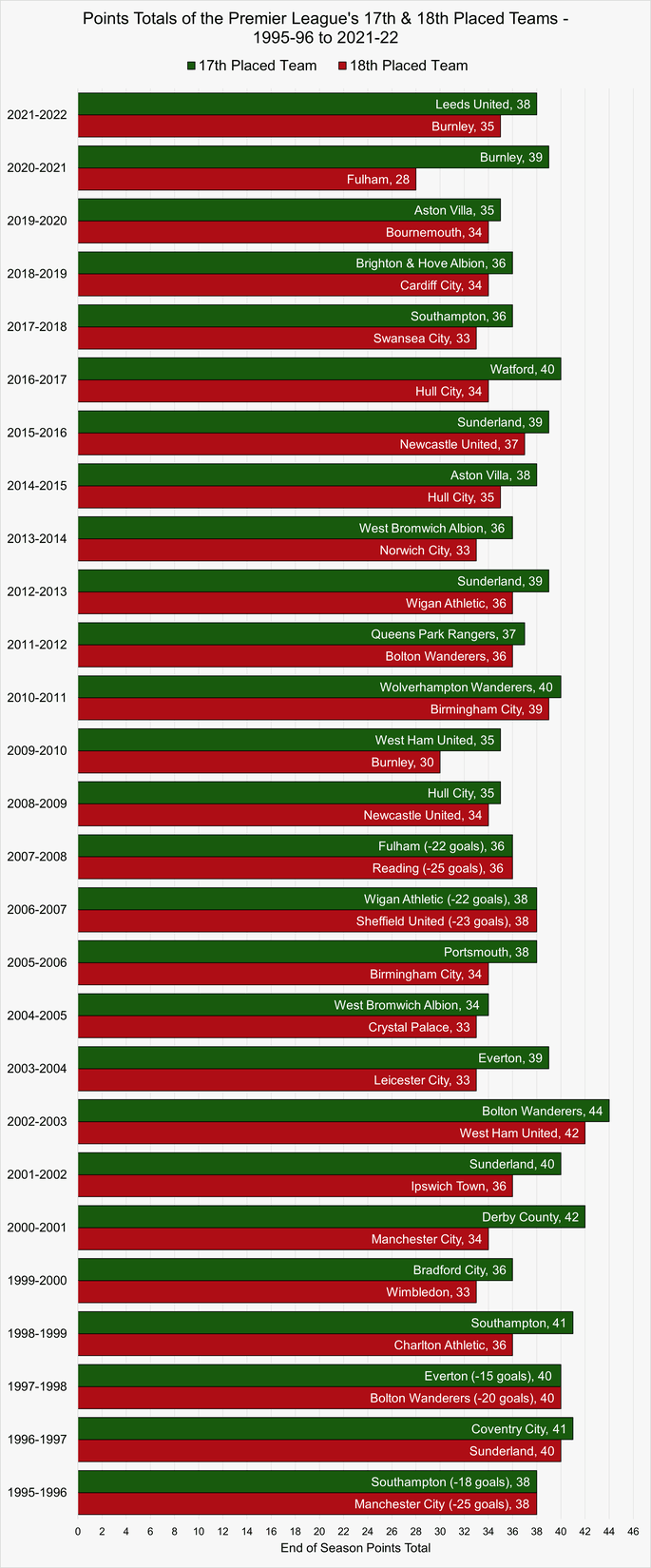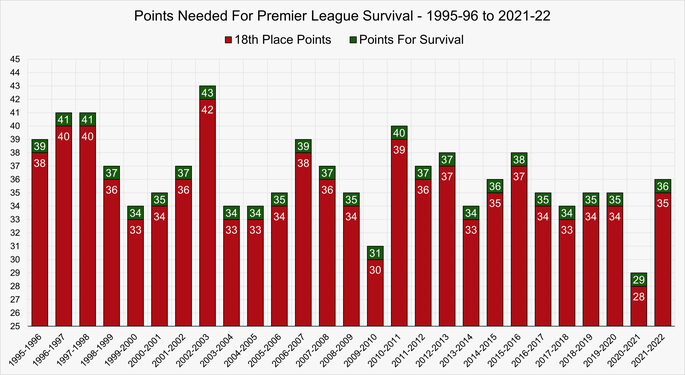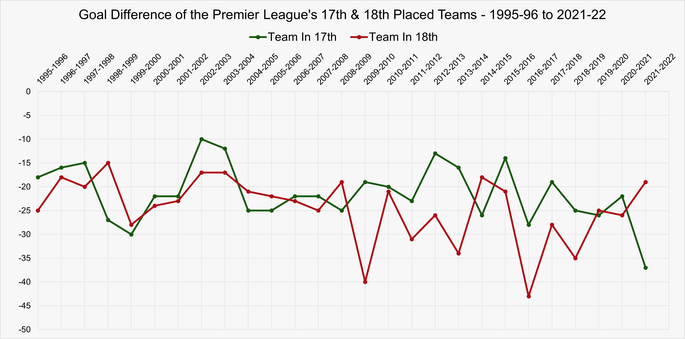 The Premier League is the pinnacle of club football in England, with the amount of money flowing around the English top-flight also suggestive of the idea that it is the most important league anywhere in Europe. The fact that European football is the best of all of the various confederations is therefore indicative of the Premier League being the best league in world football. Little wonder, then, that teams are so desperate to remain in it every time a league season takes place. The question is, how many points do you need to do so?
The Premier League is the pinnacle of club football in England, with the amount of money flowing around the English top-flight also suggestive of the idea that it is the most important league anywhere in Europe. The fact that European football is the best of all of the various confederations is therefore indicative of the Premier League being the best league in world football. Little wonder, then, that teams are so desperate to remain in it every time a league season takes place. The question is, how many points do you need to do so?
It is often touted that 40 points is the magic number when it comes to Premier League survival. It is the figure that teams will often aim for if their main hope during a top-flight league campaign is nothing more than survival. Even so, some teams have hit 40 points and still been relegated, whilst others have struggled to get there but managed to remain in the league for at least another season. That means that there is no definitive answer, but we can take a look to see what the minimum number of points needed is to survive the relegation battle.
Quick Answer: How Many Points Does a Team Need to Avoid Relegation from the Premier League?
Between the 1995-96 and 2021-22 seasons, the average number of points earned by the team finishing 17th (fourth from bottom) in the Premier League was 38.15. In this same period, when the league has consisted of 20 teams, the team finishing 18th (highest placed relegated team) averaged 35.22 points.
West Bromwich Albion in the 2004-05 season survived with the lowest points total of any 17th placed team with 34 points. West Ham United in 2002-03 finished in 18th place and were relegated with 42 points, the most of any team that has gone down.
Looking Back Over Previous Seasons

When the Premier League first launched, it did so with 22 teams battling it out. That meant that each side played 42 times and there were therefore more points on offer. The team with the highest number of points to still be relegated was Crystal Palace, who notched up 49 points but missed out on survival to Oldham Athletic, who also got 49 points but had a better goal difference. There remained 22 teams the following season, when Sheffield United got 42 points but went down and Ipswich Town survived with 43.
The 1994-1995 campaign was the final one in which there were 22 teams present, made even more tricky to survive on account of the fact that four teams were relegated in order to help reduce the number of teams playing to 20. It was Crystal Palace that missed out on survival once again, this time with 45 points, whilst Aston Villa narrowly avoided the drop with 48. The fact that there were so many points available means that we’re not going to look at the 22-team seasons, given the fact that it will skew our information.
Instead, we’re going to look at the 1995-1996 season onwards, when there were 20 teams playing in the division and it was three points for a win and one for a draw. We will look at the team that finished 17th and survived, as well as the team that finished 18th and got relegated, taking into account the number of points achieved by the two teams. Where two teams have finished on the same number of points we will show the goal difference, helping to let us know why one was relegated and which stayed up.

It is clear from the table that 40 points would be enough to keep you safe in most seasons, with only one of the campaigns since the Premier League went to 20 teams seeing the team that finished in 18th get 39 points. There were, in fact, three occasions when the team finishing 18th got 40 points or more, so 40 points would not have been a guarantee of survival in that instance. It is a points tally to aim for, but not one that will ensure safety if the other teams at the bottom of the table have notched up more points.
How Many Points Are Needed to Avoid Relegation
Now that we know exactly how many points were achieved by the teams that finished 17th and 18th during the 20-team Premier League seasons, we can work out how many points would be enough in the majority of campaigns. We can do that by looking at the points that the 18th-placed teams got each season and then figuring out how many points would have been enough to stay up. For the purposes of this, we’re going to imagine that the team in 17th has an inferior goal difference to the one in 18th, which has been the case eight times since 1996.
That allows us to remove goal difference as a possible deciding factor, meaning that it is just the points that we’re interested in. Here is a look at the points managed by the team that finished 18th as well as how many points the team that finished 17th could have survived with:

Highs, Lows & Averages
Using the information from our second table, we can now see that the highest number of points that have been required to remain in the Premier League was 43, thanks to West Ham United getting relegated with 42 points at the end of the 2002-2003 campaign. That is the only time that a figure that high has been needed in order to ensure survival, with 40 points as the magic number being more than enough in all but that season, the 1996-1997 campaign and 1997-1998. On those two occasions, first Coventry City got 41 points and then Everton got 40 points and both stayed up.
The fewest points achieved by a team that survived in 17th place was 34 points, which has actually only happened once. West Bromwich Albion in the 2004-2005 season managed to stay up with such a low total, showing that it can be done. Managers often have to think about which three teams are likely to be worse than the side that they’re operating with, doing whatever they can to earn more points than them and therefore managing to avoid the drop at the expense of the others.
Across the 27 league seasons that we’ve looked at, a team would have been able to stay up without depending on goal difference with an average of 38.15 points. The 40 points ‘magic number’ that is often touted regarding survival actually lends teams a healthy amount of wiggle room. It would be more than enough in nearly 89% of seasons to keep you in the division, with only about 11% of the time where 40 points would still result in a team dropping down to the Championship. Good news for managers with struggling teams.
In terms of relegation, the average number of points that relegated teams managed to achieve across the 27 campaigns was 35.22. In other words, on average, 36 points will be enough for survival in the battle to remain in the Premier League.
How Important Is Goal Difference To Survival?

There have been four occasions since the Premier League went to 20 teams when the team in 17th and the team in 18th finished the season with exactly the same number of points. Those seasons and teams were as follows:
Premier League Teams Relegated on Goal Difference – 1995-96 to 2021-22
| Season | Points | 17th Team (GD) | 18th Team (GD) |
|---|---|---|---|
| 1995-1996 | 38 | Southampton (-18) | Manchester City (-25) |
| 1997-1998 | 40 | Everton (-15) | Bolton Wanderers (-20) |
| 2006-2007 | 38 | Wigan Athletic (-22) | Sheffield United (-23) |
| 2007-2008 | 36 | Fulham (-22) | Reading (-25) |
On each occasion, the Premier League rules were such that the team with the better goal difference remained in the top-flight, whilst the other side was relegated out of it. That obviously leads us to ask just how important goal difference is to Premier League survival. It was only relevant 18.51% of the time, but it could be the difference between a team remaining in the best league in the world and a side slipping out of it. Here is the goal difference notched up by the 17th-placed team and the 18th-placed team across the 27 campaigns that we’ve been looking at:

* In the 1995-96 season, Coventry City also got 38 points, scoring 42 goals, conceding 60 and having a goal difference of -18
There is an old adage in the Premier League that each goal scored is worth a point, hence including both values in the table above. You can see that that isn’t totally true most of the time, but it is a guide when it comes to how many points teams tend to rack up. It doesn’t happen often that teams have significantly more goals to their name than points or vice versa. The two metrics are often close to each other, explaining the importance of goals to Premier League defences.
When it comes to averages, here’s how they shake out:
Average Premier League Goal Difference – 1995-96 to 2021-22
| Team In 17th | Team In 18th | |
|---|---|---|
| Goals Scored | 39.04 | 38.04 |
| Goals Conceded | 60.48 | 62.63 |
| Goal Difference | -21.44 | -24.59 |
That table makes for really interesting reading for teams hoping to stay in the Premier League and avoid the drop. Though there are some obvious outliers that have taken place over the years, the average number of goals scored across the 27 seasons that we’re looking at isn’t too dissimilar between the teams that finished 17th and those that finished 18th, with exactly one goal in it. Even the goals conceded isn’t massively different, but on average teams in 18th concede a little over two goals more across the course of a campaign.
By the time the goal scored is added and the goals conceded are taken away, you’re looking at an average goal difference of more than three. It shows that it is fine margins, but that being able to put the ball into the back of the opposition’s net and keep it out of your own is the key factor to survival, as obvious a point as that might be to say.
